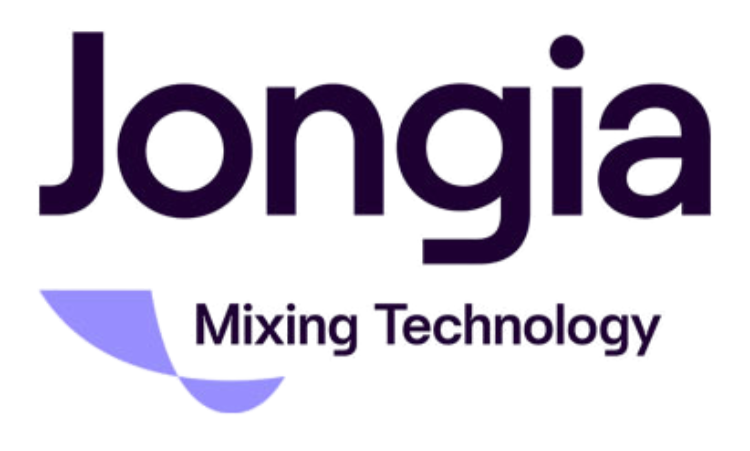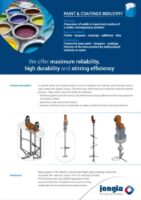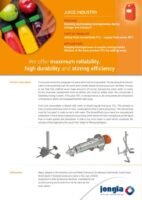Bottom Entry Agitators
Light Duty Bottom Entry Agitators
Types: JMB
Light duty bottom entry agitators and mixers are the best fit for applications like keeping dairy products homogenous and vegetable oil or juice storage.
These applications are characterized by:
- Fluids which are easily mixed or kept homogeneous
- Small tank volumes
- Low viscous fluids
- Tanks with low pressure (max. 10 bar g)
- Temperatures from -20 °C to 150 °C
- Generated torque relatively low
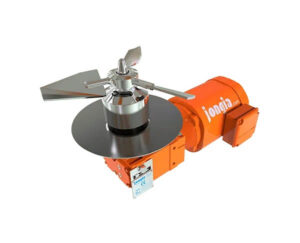
| Light Duty Bottom Entry | |
|---|---|
| Motor power | 0.25 kW – 4 kW |
| Materials | Stainless Steel 304, 316 L, Duplex (Super), Hastelloy C4 or C2000, Titanium Grade 2 or 7 |
| Coatings | C3, C4, C5 of C5M |
| Surface wetted parts | Ground until Ra < 0,4 µm, handpolished till <0,2 μm or electropolished |
| Explosion proof (ATEX) | Ex zone 0, 1 or 2 for gas, 21 or 22 for dust or Non-Ex version |
| Accessories | Direct or gear driven (all brands), all kinds of sealing systems, adapted flanges to vessel, welded or bolted versions |
Medium Duty Bottom Entry Agitators
Types: JRWB
Medium duty bottom entry agitators and mixers are suitable for applications like vegetable oil storage, dairy products and juice storage.
These applications are characterized by:
- Mixing applications where higher forces are required
- Larger tank volumes up to approx. 100 m3
- Viscosities range up to approx. 5000 cP
- Pressurized tanks (max. 16 bar g)
- Temperatures from -20 °C to 170 °C
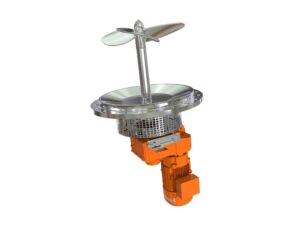
| Medium Duty Bottom Entry | |
|---|---|
| Motor power | 0,75 kW - 11 kW |
| Materials | Stainless steel 304, 316 L, Duplex (Super), Hastelloy C4 or C2000, Titanium Grade 2 or 7 |
| Coatings | C3, C4, C5 of C5M |
| Surface wetted parts | Ground until Ra < 0,4 µm, handpolished till <0,2 μm or electropolished |
| Explosion proof (ATEX) | Ex zone 0, 1 or 2 for gas, 21 or 22 for dust or Non-Ex version |
| Accessories | Direct or gear driven (all brands), all kinds of sealing systems, adapted flanges to vessel, welded or bolted versions |
Heavy Duty Bottom Entry Agitators
Types: HDMB
Blending (petro)chemical, food or pharmaceutical products for instance in reactors are examples of heavy duty applications where bottom entry agitators and mixers are selected.
These applications are characterized by:
- Mixing applications where extremely high forces are required
- Very large tank volumes where a bottom bearing is not desirable
- Highly viscous fluids exceeding even 100.000 cP
- High pressure tanks exceeding even 100 bar g
- Temperatures exceeding even 250 °C
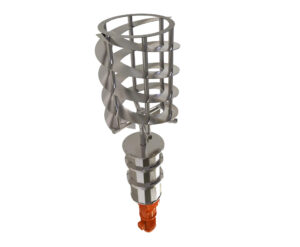
| Heavy Duty Bottom Entry | |
|---|---|
| Motor power | 15 kW - 200 kW |
| Materials | Stainless steel 304, 316 L, Duplex (Super), Hastelloy C4 or C2000, Titanium Grade 2 or 7 |
| Coatings | C3, C4, C5 of C5M |
| Surface wetted parts | Ground until Ra < 0,4 µm, handpolished till <0,2 μm or electropolished |
| Explosion proof (ATEX) | Ex zone 0, 1 or 2 for gas, 21 or 22 for dust or Non-Ex version |
| Accessories | Direct or gear driven (all brands), all kinds of sealing systems, adapted flanges to vessel |
Frequently Asked Questions
What are bottom entry agitators?
Bottom entry agitators are mixing devices specifically designed for various industrial applications. They come in three different capacities—light, medium, and heavy duty—to meet the diverse needs of industries such as food and pharmaceuticals. Each type has unique features tailored for specific applications.
What types of materials are used for bottom entry agitators?
Bottom entry agitators are constructed from high-quality materials, including stainless steel 304, 316 L, Duplex (Super), Hastelloy C4 or C2000, and Titanium grades 2 or 7. These materials ensure durability and resistance to corrosion in demanding environments.
What applications are suitable for light duty bottom entry agitators?
Light duty bottom entry agitators are suitable for applications involving low-viscosity fluids, such as storing dairy products, vegetable oils, and juices. They are efficient for mixing small tank volumes under low pressure and can withstand temperatures between -20 °C to 150 °C.
What are the key features of heavy duty bottom entry agitators?
Heavy duty bottom entry agitators are designed for extreme applications requiring high mixing forces. They can handle highly viscous fluids, large tank volumes, and high-pressure environments, with maximum pressures exceeding 100 bar g and temperatures above 250 °C.
Are the agitators explosion-proof?
Yes, all bottom entry agitators can be configured to be explosion-proof (ATEX compliant). They can be adapted for various explosive zones, ensuring safe operation in environments where flammable gases or dust may be present.
Contact our specialized team for all your questions

Tom Pruymboom
Sales Director
Area Worldwide

Bart Brouwer
Area Sales Manager
Area Worldwide
Related Articles
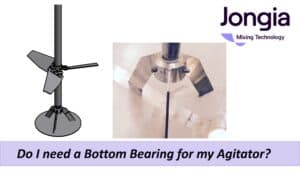
Do I need a Bottom Bearing for my agitator?
Do I need a Bottom Bearing? The installation of a bottom bearing is not mandatory. While it offers certain advantages, there are also drawbacks to consider. It is important to note that the bottom bearing functions more as a displacement
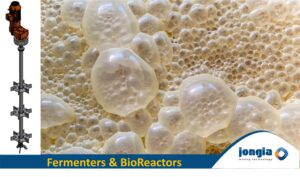
Fermentation & Bioreactor Mixing Process
Bioreactors and Fermenters are culture systems to produce cells or organisms. They are used in various applications, including basic research and development, and the manufacturing of biopharmaceuticals, food and food additives, chemicals, and other products. A broad range of cell types and organisms can be cultivated in bioreactors and Fermenters, including cells (like mammalian cell lines, insect cells, and stem cells), microorganisms (like bacteria, yeasts, and fungi), as well as plant cells and algae. The words “Bioreactor” and “Fermenter” are basically the same thing.
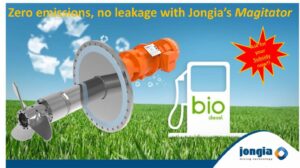
Biodiesel blending with zero leakage!
Fuel blending is a critical component of biodiesel production. A properly blended fuel can increase energy efficiency, reduce emissions and improve performance. However, it can be difficult to achieve consistent fuel quality during blending due to differences in storage tanks,
